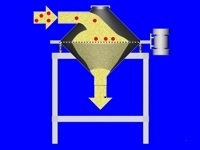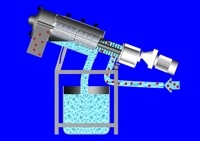Eddy current screen
Eddy current screening is a mechanical process for removing impurities from bulk materials by means of screening .
Areas of application
- Control sieves
The main field of application of eddy current screens is control screening. In many industries, high-quality raw materials without contamination are the prerequisite for hygienic production. With modern screening machines, foreign substances can be excluded in bulk materials and liquids. They check the bulk goods before, during and after the manufacturing process and also ensure compliance with HACCP - on January 1, 2006, the EC regulation no. 852/2004 on food hygiene came into force. As an important component of automatic feed systems, screening systems make a significant contribution to quality assurance . Before and after processing, eddy current screening machines ensure that no foreign bodies or impurities remain in the raw material or packaging residues in the product.
- Dissolve lumps
Eddy current sieving machines completely dissolve lumps, regardless of whether they arise in hygroscopic materials, through prolonged storage or during mixing and drying. In this way, the machines ensure the quality of the end product and at the same time avoid losses.
- Separate
During production, e.g. B. When drying milk powder, hard agglomerates are formed . The screening machines separate these reliably.
- Loosen up
In the food industry in particular , sieving machines are used to loosen up raw materials. For example, a sieve machine directly in front of a dough mixer enriches the flour with air, loosens it and in this way increases the flour yield significantly.
- Win back
Fine and coarse components that arise in production processes can be recovered, e.g. B. during compaction of powders, the dusting of candy or the epoxy - powder coating process .
- Fractionation
Eddy current screening machines cleanly and reliably separate powdery bulk materials into different grain sizes.
Pre-screening as the first protection for product and system
When feeding the individual bulk goods into the automatic process, it must be ensured that no contaminants enter the production. Here in particular, it is important to sort out packaging residues, foreign substances or other parts. Front or protective sieves in filling hoppers, big bag or container feed stations hold back coarse contaminants as early as the product feed. The sieves can be easily checked and cleaned through an inspection opening or pull-out device.
Pre-screening in closed conveying streams
The tank truck screening machine controls all free-flowing and powdery bulk materials in closed, pneumatic conveying flows. As a pre-screen, it mainly works on the conveyor route between the silo vehicle and the storage silo. The screening machine effectively prevents impurities or lumps from being fed into the silos. This additional incoming inspection increases security and quality.
Control sieves in closed conveying streams
When it comes to control sieves within the production process, thanks to their superior technology, the eddy current sieving machines provide excellent service at practically any point in the production process by automatically removing impurities.
Separates solid from liquid
Even in the liquid sector, eddy current technology ensures a longer life cycle for the downstream devices, such as B. Filters, presses etc .: The operating / usage times increase five to ten times. Agglomerates , which arise when powder is stirred into liquids, are continuously removed by the liquid screening machine. For example, it separates cheese dust from whey or fruit residues from juices.
Individual degrees of fineness
Depending on the engine speed and mesh size, the liquid screening machine has a throughput of 40,000 l / h. The degree of fineness of the sieving depends on individual requirements. Sieve inserts from a mesh size of 10 µm hold back even the smallest solids. The sieves clean themselves and can be replaced without tools if necessary.






